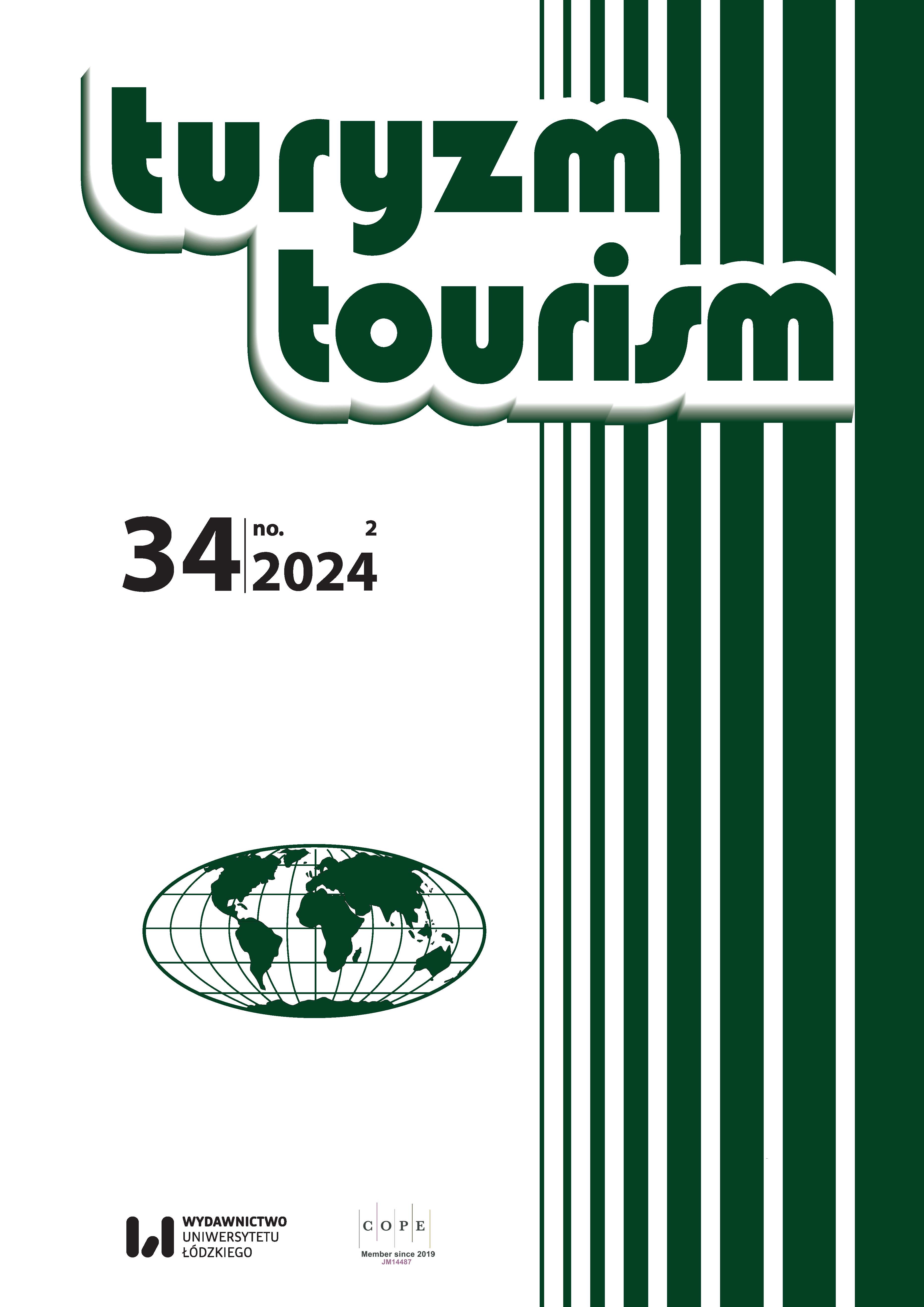Customer-perceived importance of restaurant attributes for casual dining, fast food and coffee shops
DOI:
https://doi.org/10.18778/0867-5856.34.2.02Keywords:
casual dining, food attribute, restaurant attribute, safety attribute, service attributeAbstract
The study aims to explore the restaurant attributes that fit specifically into three different types of food and beverage businesses: casual dining, fast food and coffee shops. The notion is based on customer-perceived importance proposed for a specific one-generation cohort. There were 519 respondents from Generation Z, gathered in mid-2023 using both printed and online questionnaires. Data were analyzed using factor analysis with SPSS. The restaurant attribute consisted of five types based on past literature, food, service, ambiance, experience and safety. However, the findings for the Gen Z context, resolved into only three types: casual dining, fast food and coffee shops, consisting of 30, 23 and 27 items respectively. To add, despite female Gen Z demanding more cleanliness than its male counterpart, both agree that quality of taste is the most important attribute for choosing a restaurant. The result of this study provides valuable information for restaurant businesses to better grasp Gen Z market’s dining habits. Restaurant operators will understand how customers evaluate the relevance of restaurant qualities differently.
Downloads
References
Ahmad, F., Ghazali, H., Othman, M., & Jules, N.J. (2017). Influence of restaurant attributes towards perceived value and customer overall satisfaction at casual dining restaurants in Klang Valley. World Applied Sciences Journal, 35, 33–39. https://www.idosi.org/wasj/wasj35(SEIHT)17/7.pdf
Google Scholar
Bae, S., Slevitch, L., & Tomas, S. (2018). The effects of restaurant attributes on satisfaction and return patronage intentions: Evidence from solo diners’ experiences in the United States. Cogent Business & Management, 5(1), Article 1493903. https://doi.org/10.1080/23311975.2018.1493903
Google Scholar
DOI: https://doi.org/10.1080/23311975.2018.1493903
Canny, I.U. (2014). Measuring the mediating role of dining experience attributes on customer satisfaction and its impact on behavioral intentions of casual dining restaurant in Jakarta. International Journal of Innovation, Management and Technology, 5(1), 25–29. https://doi.org/10.7763/IJIMT.2014.V5.480
Google Scholar
DOI: https://doi.org/10.7763/IJIMT.2014.V5.480
Cheng, C.-C., Wu, H.-C., Tsai, M.-C., Chang, Y.-Y., & Chen, C.-T. (2020). Determinants of customers’ choice of dining-related services: The case of Taipei City. British Food Journal, 122(5), 1549–1571. https://doi.org/10.1108/BFJ-07-2019-0566
Google Scholar
DOI: https://doi.org/10.1108/BFJ-07-2019-0566
Choi, H., Choi, E.-K., Yoon, B., & Joung, H.-W. (2020). Understanding food truck customers: Selection attributes and customer segmentation. International Journal of Hospitality Management, 90, Article 102647. https://doi.org/10.1016/j.ijhm.2020.102647
Google Scholar
DOI: https://doi.org/10.1016/j.ijhm.2020.102647
Choi, S., Yang, E.C.L., & Tabari, S. (2020). Solo dining in Chinese restaurants: A mixed-method study in Macao. International Journal of Hospitality Management, 90, Article 102628. https://doi.org/10.1016/j.ijhm.2020.102628
Google Scholar
DOI: https://doi.org/10.1016/j.ijhm.2020.102628
Choi, J., & Zhao, J. (2014). Consumers’ behaviors when eating out: Does eating out change consumers’ intention to eat healthily? British Food Journal, 116(3), 494–509. https://doi.org/10.1108/BFJ-06-2012-0136
Google Scholar
DOI: https://doi.org/10.1108/BFJ-06-2012-0136
Chun, S.-H., & Nyam-Ochir, A. (2020). The effects of fast food restaurant attributes on customer satisfaction, revisit intention, and recommendation using DINESERV Scale. Sustainability, 12(18), Article 7435. https://doi.org/10.3390/su12187435
Google Scholar
DOI: https://doi.org/10.3390/su12187435
Cobanoglu, C., Bilgihan, A., Nusair, K., & Berezina, K. (2012). The impact of Wi-Fi service in restaurants on customers’ likelihood of return to a restaurant. Journal of Foodservice Business Research, 15(3), 285–299. https://doi.org/10.1080/15378020.2012.706194
Google Scholar
DOI: https://doi.org/10.1080/15378020.2012.706194
Dimock, M. (2019, March 17). Defining generations: Where Millennials end and Generation Z begins. Pew Research Center. http://tony-silva.com/eslefl/miscstudent/downloadpagearticles/defgenerations-pew.pdf
Google Scholar
Do, H. (2020). A study on importance and satisfaction of Michelin restaurant selection attributes: Starred restaurants and Bib Gourmand restaurants. Journal of the Korean Society of Food Culture, 35(1), 55–64. https://doi.org/10.7318/KJFC/2020.35.1.55
Google Scholar
Erkmen, E. (2019). Managing restaurant attributes for destination satisfaction: What goes beyond food? Administrative Sciences, 9(1), Article 19. https://doi.org/10.3390/admsci9010019
Google Scholar
DOI: https://doi.org/10.3390/admsci9010019
Erkmen, E., & Hancer, M. (2019). Building brand relationship for restaurants: An examination of other customers, brand image, trust, and restaurant attributes. International Journal of Contemporary Hospitality Management, 31(3), 1469–1487. https://doi.org/10.1108/IJCHM-08-2017-0516
Google Scholar
DOI: https://doi.org/10.1108/IJCHM-08-2017-0516
Gen Z prioritizes in-store WiFi. (2017, May 30). Retail Info System News. https://risnews.com/report-gen-z-prioritizes-store-wifi
Google Scholar
Gomez, K., Mawhinney, T., & Betts, K. (n.d.). Welcome to Generation Z. Network of Executive Women & Deloitte. https://www2.deloitte.com/content/dam/Deloitte/us/Documents/consumer-business/welcome-to-gen-z.pdf
Google Scholar
Ha, J., & Jang, S.(S.). (2013). Attributes, consequences, and consumer values: A means-end chain approach across restaurant segments. International Journal of Contemporary Hospitality Management, 25(3), 383–409. https://doi.org/10.1108/09596111311311035
Google Scholar
DOI: https://doi.org/10.1108/09596111311311035
Hair, J.F., Jr., Black, W.C., Babin, B.J., & Anderson, R.E. (2014). Multivariate data analysis: A global perspective (7th ed.). Pearson Education.
Google Scholar
Halimi, F.F., Gabarre, S., Rahi, S., Al-Gasawneh, J.A., & Ngah, A.H. (2021). Modelling Muslims’ revisit intention of non-halal certified restaurants in Malaysia. Journal of Islamic Marketing, 13(11), 2437–2461. https://doi.org/10.1108/JIMA-01-2021-0014
Google Scholar
DOI: https://doi.org/10.1108/JIMA-01-2021-0014
Harrington, R.J., Ottenbacher, M.C., & Kendall, K.W. (2011). Fine-dining restaurant selection: Direct and moderating effects of customer attributes. Journal of Foodservice Business Research, 14(3), 272–289. https://doi.org/10.1080/15378020.2011.594388
Google Scholar
DOI: https://doi.org/10.1080/15378020.2011.594388
Jeon, J., Yoo, M., & Christodoulidou, N. (2019). The impact of Wi-Fi service on millennial diners. Journal of Hospitality and Tourism Technology, 10(3), 383–400. https://doi.org/10.1108/JHTT-11-2017-0133
Google Scholar
DOI: https://doi.org/10.1108/JHTT-11-2017-0133
Kolb, B. (2018). Marketing research for the tourism, hospitality and events industries. Routledge.
Google Scholar
DOI: https://doi.org/10.4324/9781315173900
Kwok, L., Huang, Y.-K., & Hu, L. (2016). Green attributes of restaurants: What really matters to consumers? International Journal of Hospitality Management, 55, 107–117. https://doi.org/10.1016/j.ijhm.2016.03.002
Google Scholar
DOI: https://doi.org/10.1016/j.ijhm.2016.03.002
Kyriazos, T.A. (2018). Applied psychometrics: Sample size and sample power considerations in factor analysis (EFA, CFA) and SEM in general. Psychology, 9, 2207–2230. https://doi.org/10.4236/psych.2018.98126
Google Scholar
DOI: https://doi.org/10.4236/psych.2018.98126
Liu, P., & Tse, E.C.-Y. (2018). Exploring factors on customers’ restaurant choice: An analysis of restaurant attributes. British Food Journal, 120(10), 2289–2303. https://doi.org/10.1108/BFJ-10-2017-0561
Google Scholar
DOI: https://doi.org/10.1108/BFJ-10-2017-0561
MacCallum, R.C., Widaman, K.F., Zhang, S., & Hong, S. (1999). Sample size in factor analysis. Psychological Methods, 4(1), 84–99. https://doi.org/10.1037/1082-989X.4.1.84
Google Scholar
DOI: https://doi.org/10.1037//1082-989X.4.1.84
Marinkovic, V., Senic, V., & Mimovic, P. (2015). Factors affecting choice and image of ethnic restaurants in Serbia. British Food Journal, 117(7), 1903–1920. https://doi.org/10.1108/BFJ-09-2014-0313
Google Scholar
DOI: https://doi.org/10.1108/BFJ-09-2014-0313
Mohd Yusof, Y.L., Wan Jusoh, W.J., & Maulan, S. (2021). Perceived quality association as determinant to re-patronise Shariah-compliant brand restaurants. Journal of Islamic Marketing, 12(2), 302–315. https://doi.org/10.1108/JIMA-10-2018-0190
Google Scholar
DOI: https://doi.org/10.1108/JIMA-10-2018-0190
Ottenbacher, M.C., Kuechle, G., Harrington, R.J., & Kim, W.-H. (2019). QSR customer sustainable behaviors and brand practice perceptions on willingness to pay a premium. International Hospitality Review, 33(2), 106–125. https://doi.org/10.1108/IHR-03-2019-0006
Google Scholar
DOI: https://doi.org/10.1108/IHR-03-2019-0006
Parasuraman, A., Zeithaml, V.A., & Berry, L.L. (1988). SERVQUAL: A multiple-item scale for measuring consumer perceptions of service quality. Journal of Retailing, 64(1), 12–40.
Google Scholar
Pizam, A., Shapoval, V., & Ellis, T. (2016). Customer satisfaction and its measurement in hospitality enterprises: A revisit and update. International Journal of Contemporary Hospitality Management, 28(1), 2–35. https://doi.org/10.1108/IJCHM-04-2015-0167
Google Scholar
DOI: https://doi.org/10.1108/IJCHM-04-2015-0167
Ponnam, A., & Balaji, M.S. (2014). Matching visitation-motives and restaurant attributes in casual dining restaurants. International Journal of Hospitality Management, 37, 47–57. https://doi.org/10.1016/j.ijhm.2013.10.004
Google Scholar
DOI: https://doi.org/10.1016/j.ijhm.2013.10.004
Rhee, H.T., Yang, S.-B., & Kim, K. (2016). Exploring the comparative salience of restaurant attributes: A conjoint analysis approach. International Journal of Information Management, 36(6 Part B), 1360–1370. https://doi.org/10.1016/j.ijinfomgt.2016.03.001
Google Scholar
DOI: https://doi.org/10.1016/j.ijinfomgt.2016.03.001
Richardson, S., Lefrid, M., Jahani, S., Munyon, M.D., & Rasoolimanesh, S.M. (2019). Effect of dining experience on future intention in quick service restaurants. British Food Journal, 121(11), 2620–2636. https://doi.org/10.1108/BFJ-09-2018-0617
Google Scholar
DOI: https://doi.org/10.1108/BFJ-09-2018-0617
Scozzafava, G., Contini, C., Romano, C., & Casini, L. (2017). Eating out: Which restaurant to choose? British Food Journal, 119(8), 1870–1883. https://doi.org/10.1108/BFJ-12-2016-0591
Google Scholar
DOI: https://doi.org/10.1108/BFJ-12-2016-0591
Selig, A. (2024, January 5). Generation influence: Reaching Gen Z in the new digital paradigm. WP Engine. https://wpengine.com/resources/gen-z-2020-full-report/
Google Scholar
Singh, G., Slack, N., Sharma, S., Mudaliar, K., Narayan, S., Kaur, R., & Sharma, K.U. (2021). Antecedents involved in developing fast-food restaurant customer loyalty. The TQM Journal, 33(8), 1753–1769. https://doi.org/10.1108/TQM-07-2020-0163
Google Scholar
DOI: https://doi.org/10.1108/TQM-07-2020-0163
Souki, G.Q., Antonialli, L.M., da Silveira Barbosa, Á.A., & Silva Oliveira, A. (2020). Impacts of the perceived quality by consumers’ of à la carte restaurants on their attitudes and behavioural intentions. Asia Pacific Journal of Marketing and Logistics, 32(2), 301–321. https://doi.org/10.1108/APJML-11-2018-0491
Google Scholar
DOI: https://doi.org/10.1108/APJML-11-2018-0491
Stangierska, D., Kowalczuk, I., Świątkowska, M., & Górska-Warsewicz, H. (2019). The influence of nutritional information upon customer attitude and behaviour in eating out establishments. Roczniki Państwowego Zakładu Higieny, 70(1), 35–40. https://doi.org/10.32394/rpzh.2019.0052
Google Scholar
DOI: https://doi.org/10.32394/rpzh.2019.0052
Stevens, P., Knutson, B., & Patton, M. (1995). DINESERV: A tool for measuring service quality in restaurants. The Cornell Hotel and Restaurant Administration Quarterly, 36(2), 56–60. https://doi.org/10.1016/0010-8804(95)93844-K
Google Scholar
DOI: https://doi.org/10.1177/001088049503600226
Tuzovic, S., Kabadayi, S., & Paluch, S. (2021). To dine or not to dine? Collective wellbeing in hospitality in the COVID-19 era. International Journal of Hospitality Management, 95, Article 102892. https://doi.org/10.1016/j.ijhm.2021.102892
Google Scholar
DOI: https://doi.org/10.1016/j.ijhm.2021.102892
Wiastuti, R.D., Lestari, N.S., Ngatemin, N., Mulyadi, B., & Masatip, A. (2020). The generation Z characteristics and hotel choices. African Journal of Hospitality, Tourism and Leisure, 9(1), 1–14. https://www.ajhtl.com/uploads/7/1/6/3/7163688/article_24_vol_9_1__2020_indonesia.pdf
Google Scholar
Yu, Y.S., Luo, M., & Zhu, D.H. (2018). The effect of quality attributes on visiting consumers’ patronage intentions of green restaurants. Sustainability, 10(4), Article 1187. https://doi.org/10.3390/su10041187
Google Scholar
DOI: https://doi.org/10.3390/su10041187
Downloads
Published
How to Cite
Issue
Section
License

This work is licensed under a Creative Commons Attribution-NonCommercial-NoDerivatives 4.0 International License.










